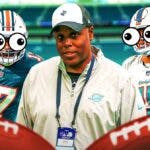Despite a 5-5 record and still being alive in the playoff hunt, the 2018 season has been a contentious one for the Miami Dolphins. Both for the team itself, and within the fan base.
This year has been yet another season marred by injury, but that hasn't stopped a portion of the fan base from calling for head coach Adam Gase to lose his job. Patience has worn thin for some, and not without reason.
The Dolphins' offense has struggled to find its bearing ever since Gase's arrival. Brought in as an “offensive genius” and “quarterback guru,” the Dolphins have sported a pedestrian — at best — offense in each of Gase's three seasons. Gase supporters will argue that he has never had a fully healthy offense for a sufficient stretch to showcase his system. And they're right. Gase's detractors will say that the head coach has run out of excuses. And they're also right.
“If you need a Hall of Fame quarterback to be considered an ‘offensive genius' and ‘quarterback guru,' you are neither.” It's something I've said numerous times on Twitter, and it's a quote I stand by. Adam Gase was brought in to turn around the Dolphins' offense. He was brought in on the promise that the numbers his offense put up in Denver would make the journey to South Beach with him.
Most of all, he was brought in to push Dolphins' quarterback Ryan Tannehill to the next level. None of those things have happened, and it has led some within the fanbase to throw Gase upon the proverbial hot seat. And it has led some of us — myself included — to wonder “Is Adam Gase overrated?”

There's a lot more that goes into being a head coach than merely how good your offense or defense is. However, as Gase was brought in with a reputation on that side of the ball, that's where this piece is going to focus. I took a look at Adam Gase's offenses throughout his career, focusing on the three pivotal marks of a good offense: moving the ball, scoring points, and converting third downs. In all three areas, Gase-led offenses come up short.
3. Moving the Ball (Yards per Game)
Adam Gase has been coaching in the NFL in some capacity for more than a decade since breaking into the league in 2005 with the Detroit Lions. Gase has made his name as an offensive genius throughout his career, working as an offensive assistant, coordinator, or head coach every year, save for two spent as a wide receivers coach in 2009 and 2010.
Gase has worked with some heavy-hitters in the offensive explosion the NFL has experienced in the past two decades, including the likes of Mike Martz and Peyton Manning. How much has Gase earned his reputation, and how much has public perception exaggerated it? That's what is examined here. The two years Gase spent as a wide receivers coach were excluded, as that role isn't his bread-and-butter.

The first mark of a good offense is how well you can move the ball. There are a lot of mitigating factors that contribute to a yards per game number, but in general good offenses tend to move the ball effectively. In today's NFL, it's easier than ever to move the ball, with rule after rule hampering defenders. Like it or not, offense brings in the ratings.
Through his coaching career, Adam Gase's offense has averaged an 18th place finish (with six games left to play in the 2018 season) in yards per game. A Gase-led offense's best finish was, not surprisingly, in 2013. That was the season Gase was the offensive coordinator for a historic Denver Broncos team with Peyton Manning. That season the Broncos finished first in the league. The previous season, as well as the following season, the offense finished fourth.
Those three years are the only seasons in Gase's career his offense has finished in the top half of the league in yards per game. If you take away the three years with Peyton Manning, the average drops to an average 23rd place finish.

2. Scoring (Points per Game)
Moving the ball is essential, but it doesn't mean much if a team can't put points on the board. Unless they possess a genuinely historic defense, teams aren't going anywhere if they're not putting the ball in the end zone. With the recent explosion in offense over the past two decades, points have naturally followed. Typically, teams are scoring with more frequency, and in more exciting ways, than they have at any point in the game's history. Gase was named the Dolphins' head coach with the idea he would bring his particular brand of high-flying offense to South Beach and provide a shot of energy to a struggling offense.
That too, however, has been far from the case for the Dolphins. In Gase's three seasons with the Dolphins, their best finish is 17th in this category. The last two seasons, Miami finished 28th in points per game in 2017, and are currently sitting at 25th this season. Yes, Ryan Tannehill missed all of 2017. Yes, Ryan Tannehill has been lost for a significant portion of this season. But how out of the ordinary is a middle-of-the-road finish in points per game for an Adam Gase offense?

Fans familiar with Adam Gase from the Denver Broncos seasons would say it's entirely out of the ordinary. During his three seasons in Denver, the Broncos never finished worse than second in points per game. The years with Peyton Manning at the helm were just about as high-flying as it gets. However, when you remove those years from the equation, Adam Gase's offenses become far more pedestrian.
The highest finish in points per game for an offense that Adam Gase has been involved with that didn't feature Peyton Manning? 2007. The 2007 Detroit Lions finished 16th that season with Adam Gase as the quarterbacks coach. For his career, Adam Gase' offenses have averaged a 19th place finish. That number drops to 23rd when you remove the Peyton Manning years.
Staying on the Field (Third Down Conversion Percentage)
The third and final point, oddly enough, third down conversion percentage. Moving the ball downfield and scoring is predicated on being able to convert on third down. Few offenses in the history of the NFL have been good enough to need only two downs to convert first downs consistently.

During the Adam Gase tenure in Miami, this has arguably been the most frustrating aspect of the offense. Having a poor third down offense not only limits a team's ability to be active on offense, but it also puts the defense at a disadvantage. The more they're on the field, the more likely they are to give up points. Points that you can't make up if you're a poor third down offense. It's a vicious cycle. One that Dolphins' fans have watched play out all too often the past three seasons.
Since Adam Gase took over in Miami, the Dolphins have finished no better than 25th in the league in third down conversion percentage. It's no coincidence that this number was put up in Gase's first year with the team, the playoff season. Since then, the Dolphins have finished dead last in 2017, and are 28th in the league so far this season.
So how does that compare to Adam Gase's previous stops? Once again, it turns out that this is more or less average for a Gase offense. Over his coaching career, Adam Gase's offense has averaged 19th in the league on third down. However, as with yards per game and points per game, that falls when you remove the Peyton Manning years. Without Manning at the helm, Gase's finishes drop to 25th.




